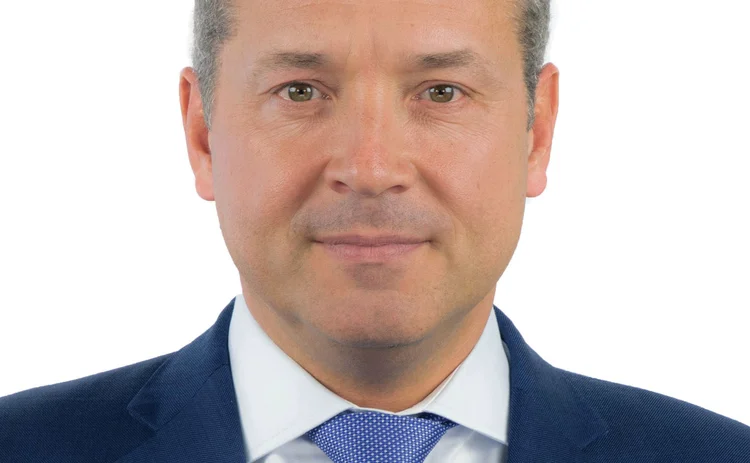
Currency derivatives house of the year: UBS
Risk Awards 2022: T-Pricer platform enabled bank to gain technological edge

The options market has viewed the pairing between the Taiwanese and US dollars as relatively liquid. Yet when a client of UBS wanted to take out a notional $5 billion of options against the pair last year, many in the market might have felt that the size of the trade would make it difficult to hedge. Despite this, the investment the bank has made in its foreign exchange options pricing and distribution tools meant it was well placed to handle it.
“In a world of increased automation, lower volatility and rapidly compressing spreads, being data-driven and tech-enabled is essentially a survival requirement,” says Adrian Boehler, UBS’s global head of FX distribution. “It is the only way in which you are going to be able to partner with clients, come thick or thin. It’s about setting ourselves up to stay relevant sustainably.”
For the USD/TWD transaction, the first thing the bank needed to work out was exactly what type of option to trade, given the goals the client had in mind. The client was first directed to T-Pricer, UBS’s system for structuring, pricing and trading FX options. Originally designed for internal use by the bank’s trading desk, it was made available to clients, at no extra cost to them, for the first time in 2021.
The client used T-Pricer’s pre-trade analytics tools to test potential structures and thereby choose the most appropriate trade, tenor and strikes. In the end, it went with billions of dollars of vanilla options, as well as digital options with payouts greater than $500 million.
For UBS, the tech upgrades helped it execute the trade and more effectively offload the risk. The bank was not only able to skew options prices across all outlets, but to match axes more quickly and efficiently with targeted clients based on past behaviour.
The Taiwan trade wasn’t a one-off, and UBS’s tech-driven setup enabled it to make a series of jumbo options trades in 2021. One was a multi-billion-dollar Swiss franc/Polish zloty options trade that it hedged by skewing prices in correlated pairs such as euro/Polish zloty, US dollar/Polish zloty and euro/Swiss franc.
UBS was also called on to execute a long-dated options structure of sterling/Australian dollar and sterling/US dollar, with a notional value just shy of $2 billion but with a vega greater than $5 million. These pairs are not highly liquid either, which required UBS to again take axes in correlated pairs to what its system identified as potentially interested clients.
Progress through technology
The tech overhaul that enabled UBS to handle these types of trade started around four years ago, when the bank boosted its IT spend by 7%. It also transferred staff from its group technology team into the FX business’s front office to form Levitas, an e-options team in which quant engineers sit back-to-back with options traders to develop pricing and analytics functionality. One of the new team’s early focuses was building T-Pricer.
For vanillas and first-generation exotics, clients already had access to a tool called Flex on Neo, UBS’s single-dealer platform, which was successful but written in a coding language that would not be supported for much longer. Instead of rewriting the existing platform into a newer language, UBS launched T-Pricer and migrated from Neo Flex, while expanding the tool’s capabilities to cover the whole options spectrum, from vanilla to complex.
T-Pricer allows clients to use the platform’s 20 years of volatility data to run pre-trade analysis on any permutation imaginable across around 400 products. Users can reprice structures using different tenors and strategies, and run grids with multiple variables with shocks of spot to see how the value of an option changes over different time frames. For structured products like dual currency deposits, users could work out the coupon that would be paid depending on the maturity and the strike price.
Clients can execute on T-Pricer and run post-trade analytics. They can also create alerts on the value of their options that send out reminders for them to restructure the trade.
In a world of increased automation, lower volatility and rapidly compressing spreads, being data-driven and tech-enabled is essentially a survival requirement
Adrian Boehler, UBS
Mathieu Reaud, global head of FX options at UBS, says clients’ ability to use T-Pricer was crucial to landing those outsized options trades: “Without this pre-trade analytics work that we’ve done with a client, we probably wouldn’t have [made] such trades.”
T-Pricer isn’t only used for jumbo options trades. Clients across the board have praised it as an intuitive, sophisticated and impressive system. Some point out that whereas other banks have stuck with the same technology or made incremental changes, UBS has twice taken the risk to deliver a better product.
“I’ve not seen any bank taking this kind of risk,” says one client whose book of business with UBS – especially in accumulators, targets and other complex trades – has increased over the past year. “Other banks prefer to make an evolution of their current platform. But to go to the extent of reworking everything, I’ve not seen that. So, it’s pretty daring from UBS.”
The client adds: “Now, with their new T-Pricer, their market share has increased in my house. They’re already up to 20% to 25% of my structured products, so they got a lot of new trades.”
Another client whose entire global team uses T-Pricer calls it the best options platform on the market. This client says they prefer UBS because it removes the baggage that makes other platforms clunky – such as the inclusion of spots, forwards and market insights – to deliver a dedicated platform for options.
“They’ve basically just gone and simplified what a derivative is,” the client says. “They’ve made it easy to build options, to value options, to structure options. There’s not a product that we can’t do. And our line of business does stuff that not many people will do, so it’s extremely far-ranging from a product perspective.
“By doing that, they end up winning far more than they used to. Our volume with UBS has probably doubled in the past six months compared with the previous six months. That is a direct result of their platform being so easy to use.”

Another aspect of UBS’s tech overhaul was focused on improving the bank’s ability to skew pricing on its e-options quotes and thereby move risk more efficiently. This effort came as decreasing FX volatility and tightening bid/offer spreads made it harder to run an options franchise. This in turn has made the ability to internalise flow – either by matching offsetting client trades internally to avoid having to go to external venues, or by skewing prices on e-platforms to get clients to take the bank out of the risk – more important than ever. Being able to do this was an important contributor in enabling UBS to handle such large trades and properly manage the risk.
In 2021, the bank introduced a risk-based skewing model for its electronic and voice-flow options trading across developed and emerging markets pairs. Although such models are commonplace in the FX spot market, their use poses far greater challenges for options because of the extra parameters involved in these types of securities. The pace of trading in options is far slower than is the case in the spot market: it might take hours to move the risk by showing skewing prices, during which UBS would be giving away valuable information about its positions to competitors.
The bank therefore built tools to enable the sales teams to create curated axes for clients. These bots help the sales team to match axes up more effectively with statistics it keeps in order to determine the clients most likely to be interested in a particular position. This ultimately allows the bank to move risk more cheaply and efficiently. Clients can also access the axes by making enquiries via the bank’s chat bot.
As a result, UBS’s internalisation rate in developed markets has risen from 67% in 2016 to 92% today. In emerging markets, its internalisation rate is now 87%, compared with 62% six years ago.
“Improving our aim very specifically means becoming more effective at finding the offsetting buying interest if we are selling, and vice versa,” says Boehler. “And what the analytics that we have enable us to do is become more data-driven in our approach. Based on historical trading patterns, we are now better able to see what part of the franchise has had potential offsetting interest to the particular risk that we’re trying to offset in the market.”
Pricing accuracy is important to guard against the bank being negatively selected – where it wins a trade only because of a mispricing, and is then left with a bad position.

UBS has made further steps over the past year to develop its options pricing infrastructure, and its traders can now view live tick-by-tick valuations of options trades. This is useful during volatile markets and feeds into the algorithms that automatically hedge the bank’s gamma exposures. Volatility surfaces are generated based on trader input, along with external data points from brokers, exchanges and aggregators, for example.>
The technology has also allowed UBS to refine its profitability metrics. The bank has moved away from hit-rate models to look at a live measure of P&L decay – something that is widely available in the linear world of FX but which is new to options. It can examine the profitability of every trade with specific clients, venues or pairs, at specific times of day or in different time zones.
“From this we can learn and price accordingly to maximise market share and remain profitable,” says Reaud.
Emerging growth
The tech upgrades have improved UBS’s ability to price emerging markets options, which last year exceeded their developed markets counterparts in terms of the share of the bank’s revenue. In the fourth quarter, UBS serviced clients during the volatility in the Turkish lira; this was helped by the bank’s ability to offset flows across its institutional and wealth management clients.
“We replaced 75% of our emerging markets options traders globally a couple of years ago,” says John Newman, global head of FX trading at UBS. “And just having those guys in the seats to deal with volatility, plus the tech build that we invested in, has really been ‘so far, so good’.
“Obviously, when the currency has moved, depreciating 16%, 17% a week, [that] has really enabled us to stay relevant to clients in terms of knowing what positions and trades to print whilst remaining solvent. And that’s really kicked our year on and enabled us to finish as strong as we are.”
The bank’s share of the electronic non-deliverable forwards market also more than doubled as it deployed new platforms and liquidity pools, and expanded the reach of its algorithmic risk management to pairs involving other currencies, including the Indonesian rupiah, the Philippine peso, the Chilean peso and the Russian ruble.
“With NDFs, we are leveraging exactly the same technology, the same low-latency platforms and algorithms for pricing and risk management as we have within the G10 spot business,” says Newman. “We have those basics, and we don’t have to rebuild them.”
Only users who have a paid subscription or are part of a corporate subscription are able to print or copy content.
To access these options, along with all other subscription benefits, please contact info@risk.net or view our subscription options here: http://subscriptions.risk.net/subscribe
You are currently unable to print this content. Please contact info@risk.net to find out more.
You are currently unable to copy this content. Please contact info@risk.net to find out more.
Copyright Infopro Digital Limited. All rights reserved.
As outlined in our terms and conditions, https://www.infopro-digital.com/terms-and-conditions/subscriptions/ (point 2.4), printing is limited to a single copy.
If you would like to purchase additional rights please email info@risk.net
Copyright Infopro Digital Limited. All rights reserved.
You may share this content using our article tools. As outlined in our terms and conditions, https://www.infopro-digital.com/terms-and-conditions/subscriptions/ (clause 2.4), an Authorised User may only make one copy of the materials for their own personal use. You must also comply with the restrictions in clause 2.5.
If you would like to purchase additional rights please email info@risk.net
More on Awards
Market liquidity risk product of the year: Bloomberg
Bringing clarity and defensibility to liquidity risk in a fragmented fixed income market
FRTB (SA) product of the year: Bloomberg
A globally consistent and reliable regulatory standardised approach for FRTB
Best use of cloud: ActiveViam
Redefining high-performance risk analytics in the cloud
Best use of machine learning/AI: ActiveViam
Bringing machine intelligence to real-time risk analytics
Collateral management and optimisation product of the year: CloudMargin
Delivering the modern blueprint for enterprise collateral resilience
Flow market-maker of the year: Citadel Securities
Risk Awards 2026: No financing; no long-dated swaps? “No distractions,” says Esposito
Pricing and analytics: fixed income – Quantifi
Quantifi delivers high-performance, transparent and adaptable pricing and risk analytics for fixed income and credit markets
Derivatives house of the year: Citi
Risk Awards 2026: Rev up, RWAs down, as US bank gets back on track (with added XiNG and XiP)







